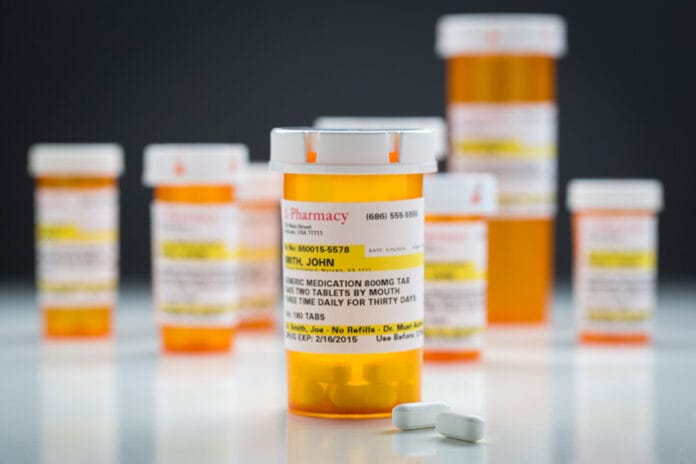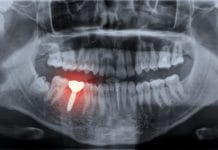Many patients who come into the dental clinic are on various medications, and it is rare and surprising when a patient over the age of 50 is not on at least one medication. An estimated 29% of Americans are taking five or more medications regularly.1
Health care has seen an increase in patients taking multiple medications as people are living longer. More systemic diseases are recognized and being treated. Dental professionals need to be aware and have a complete understanding of possible drug interactions and adverse effects.
This paper includes the most common medications I have encountered while treating dental patients in the Texas State Technical College (TSTC) dental hygiene program for the last two semesters.
Tracking Dental Patients’ Medications
Many medications ‒ including vitamins and supplements ‒ in combination with systemic disease can have negative effects on oral health. The most common side effect of medications is xerostomia. Other issues such as abnormal gingival bleeding, gingival hyperplasia, osteonecrosis of the jaw, and problems with blood clotting can occur.
There can also be adverse effects from these medications and contraindications for dental treatment. Certain foods can interact negatively with certain drugs, and some medicines taken together can also interfere with each other.
For these reasons, it is important to have a thorough medical history when treating patients. The medical history should include any systemic issues or disease, allergies, prescription medications along with dietary supplements, and past surgeries.
In clinic, I have seen 26 patients. Of these 26 patients, only four reported they were not taking any medications or supplements. Three out of four of those patients not taking medications were under the age of 20 years old, and the fourth was over the age of 60. Keeping a record of all my patients’ medications, I have seen a total of 18 medications and one vitamin (see Table 1).
Table 1: Patient medications
| Drug | Mechanism of Action | Indication |
| Montelukast | Leukotriene receptor antagonist | Bronchodilator and anti-inflammatory: asthma |
| Atorvastatin | HMG-CoA reductase inhibitor | Statin: cholesterol and triglyceride level reduction |
| Benazepril | ACE inhibitor | Antihypertensive |
| Chlorthalidone | Loop diuretic | Diuretic and antihypertensive |
| Lisinopril | ACE inhibitor | Antihypertensive |
| Metoprolol | Beta 1-selective adrenergic receptor blocker | Antihypertensive |
| Metformin | Decreases hepatic glucose production, decreases intestinal absorption of glucose, and improves insulin sensitivity | Antihyperglycemic |
| Duloxetine | SNRI | Antidepressant: nerve pain, fibromyalgia, chronic bone and muscle pain |
| Divalproex | Valproate | Anticonvulsant |
| Gabapentin | GABA mimetic | Anticonvulsant also used for nerve pain |
| Aleve | COX inhibitor | NSAID: inflammation, pain, and fever reduction |
| Aspirin | COX inhibitor | NSAID: inflammation, pain, fever reduction, and anticoagulant |
| Meloxicam | COX inhibitor | NSAID: inflammation, pain, and fever reduction |
| Tramadol | Mu receptor agonist | Synthetic opioid: pain relief for moderate to severe pain |
| Omeprazole | PPI | Heartburn, GERD, ulcers |
| Alendronate | Osteoclast inhibitor | Bisphosphonate: osteoporosis, Paget’s disease |
| Levothyroxine | Synthetic thyroxine | Hypothyroidism, enlarged thyroid gland, thyroid cancer |
| Fluticasone | Selective glucocorticoid receptor agonist | Allergy relief, pain, itching, and swelling |
| Prenatal vitamins | various | Treat or prevent vitamin deficiency |
Many patients were on multiple medicines. For example, one patient was on six different medications that help manage different systemic issues. When medications are taken in combination, it is called polypharmacy. Polypharmacy increases the risk of adverse drug reactions, oral implications, and can even lead to unintentional overdose.2
One Patient, Three Medications
To illustrate the effects of polypharmacy on oral-systemic care, I will review three medications: Lisinopril, alendronate, and meloxicam.
A 73-year-old patient had several systemic issues, including rheumatoid arthritis (RA), hypertension, type 2 diabetes mellitus (T2DM), high cholesterol (HCL), Parkinson’s disease, and past depression, to name a few.
The patient states she gets her medications and her dental work completed in Mexico. She had not had dental treatment in over three years but acknowledges it could have been longer than three years.
On the patient’s first visit, I noticed that the patient was overweight. Upon further inquiries about the patient’s health history, I found she had a BMI of 42% which is considered morbidly obese. Due to rheumatoid arthritis, the patient uses a cane to walk and moves slowly. She is considered an ASA II due to obesity, T2DM, hypertension, and RA.
After conducting the IO/EO exam and periodontal assessments, the patient’s dental diagnosis was periodontitis stage II, grade B, and calculus type II. Her gingival tissues were inflamed with bleeding upon probing in most posterior teeth. Bone loss was considered slightly above the coronal 3rd with 1-5mm probing depths and localized recession from 2-7mm on the upper left molars. After viewing the dental radiographs, the doctor diagnosed several open margins on crowns and bridges, heavy calculus deposits on most interproximal posterior teeth, horizontal bone loss, and three teeth with recurrent decay.
This information aims to express how medications can interact with one another and any oral and systemic implications they may have. I will delve into what each of these medications is used for, side effects, drug interactions, and contraindications for dental treatment.
Lisinopril ‒ Lisinopril’s drug class is an angiotensin-converting enzyme also called an ACE inhibitor.3 It is an antihypertensive agent used to treat cardiovascular disease, acute myocardial infarction, heart failure, and hypertension. Lisinopril is considered a first-line drug that preserves renal function in patients with high blood pressure and who are diabetic.4
Adverse effects that may interfere with dental treatment include orthostatic hypotension when standing after prolonged treatment in the supine position and a dry, hacking cough. No effects on bleeding or local anesthesia with epinephrine precautions are listed for lisinopril.3 Xerostomia is a side effect that can increase the risk for carries and oral candidiasis.3
Drug interactions include nonsteroidal anti-inflammatory drugs (NSAIDs), which may reduce the effectiveness of ACE inhibitors resulting in rapid elevation of blood pressure. Food high in potassium, such as bananas, potatoes, tomatoes, and squash, should be avoided in excess because lisinopril can increase blood potassium levels.1
Alendronate ‒ Alendronate is in the class of drugs called bisphosphonates. Brand names include Binosto and Fosamax. It prevents bone breakdown by increasing bone density. It is indicated for osteoporosis, including RA-associated osteoporosis, hypercalcemia with metastatic cancer, chronic renal disease in patients undergoing dialysis, and Paget’s disease.5
One of the dental risk factors for this medication is osteonecrosis of the jaw (ONJ). It is generally associated with tooth extractions, periodontal surgeries, non-surgical periodontal therapy/SRP, and infection and can occur spontaneously without any dental procedure.
The risk of osteonecrosis is 0.1%, meaning that out of every 1,000 people, only one person is at risk for this condition.6 Age increases the risk, as does smoking and wearing dentures. Another risk is gastrointestinal bleeding. This medication should be used cautiously in patients with gastritis or ulcers because of the risk of developing upper gastrointestinal bleeding.7 Dietary considerations for this medicine include adequate vitamin D and calcium as well as taking the medication on an empty stomach, preferably first thing in the morning, to avoid possible food interactions.
Meloxicam ‒ Meloxicam is a nonsteroidal anti-inflammatory drug (NSAID) that inhibits prostaglandin synthesis (PGE2) and inhibits COX-1 and COX-2, resulting in reduced inflammation.8 This medication is widely used for its analgesic properties and anti-inflammatory in dental care. It may be used to manage acute dental pain and chronic orofacial pain in the treatment of periodontal disease.9
This medication, when mixed with ACE inhibitors like lisinopril, can counteract the antihypertensive effects and can lead to a recurrence of heart failure. When taken in conjunction with bisphosphonates such as alendronate (Fosamax), the patient may experience increased bleeding, prolonged bleeding, and GI perforation and bleeding.10 Although these events are a life-threatening concern, they are uncommon.
Other effects of meloxicam are nausea, vomiting, and dyspepsia. Oral implications include gingival bleeding and xerostomia due to disturbances of salivary secretion.
Patient Reaction to Treatment
The three medications discussed ‒ lisinopril, alendronate, and meloxicam ‒ have dental implications and adverse effects. Special accommodations needed to be taken during her patient care. Because the patient is diabetic, I scheduled her for a morning appointment and recommended she have breakfast prior to her appointment.
Her vitals and blood glucose level were taken at the start of each appointment. Her blood pressure readings were elevated during all four appointments, but her glucose levels were within normal limits.
The patient informed me prior to treatment that she experiences dizziness upon standing, which is an effect of lisinopril. Orthostatic hypotension occurs when a person is lying back for a period and gets lightheaded or dizzy upon sitting up or standing too quickly. While treating her, she did become slightly dizzy and had to sit for a few minutes prior to standing. When she did stand, she was still slightly off-balance, and I had to ask her to sit down again so that she would not fall.
The patient also had a dry, nonproductive cough during treatment which can be caused by the same medication. I had water available for her to sip throughout the appointment, and we took several breaks due to the coughing.
The patient also reported suffering from xerostomia. One thing that surprised me is that the patient knew what medications she was prescribed but not the correlating conditions the medications were used to treat or the potential side effects. For example, she was taking a bisphosphonate but did not know it was to treat her RA-associated osteoporosis nor that the drug could increase the risk of ONJ. I explained what osteonecrosis is and had her sign the proper authorization paperwork prior to treatment. The patient should get a release from their physician prior to dental treatment or sign a consent that they understand the risk of ONJ after dental treatment. Patients taking bisphosphonate should be observed closely after dental procedures.
Patient Recommendations
Due to the patient’s systemic diseases, I recommended that she start an exercise regimen and pay more attention to her diet, overall health, and oral health. This was my advice due to her high BMI of 42%, which is considered morbidly obese. I explained that modifications to her diet and at least 30 minutes of daily exercise can help decrease fat and reduce the risk of cardiovascular disease. Exercise can also help control blood sugar levels. We spoke in-depth about the relationship between systemic diseases and their link to oral health.
I spoke to the patient about the effect of her medications on oral health. I explained that most medications cause xerostomia. Dry mouth can increase the risk of dental caries due to the lack of saliva. Saliva washes away food particles that are left in the mouth after eating. It helps protect from cavities because the bacteria produce acids that destroy the enamel, which leads to decay. I encouraged her to drink more water to stay hydrated and help with her xerostomia due to polypharmacy.
We talked about her dry hacking cough and loss of taste both of which can be a side effects of lisinopril. The thing that surprised me the most was that she wasn’t aware she was taking a bisphosphonate medication, and she didn’t know what it was used for. I explained that it is an osteoclast inhibitor used for conditions such as osteoporosis, RA-associated osteoporosis, and other diseases of the bone.
We discussed the risk factors of alendronate, such as osteonecrosis of the jaw linked to extractions, periodontal surgeries, and other dental procedures. ONJ is the death of tissue and bone due to a lack of blood supply. She admitted that she had never heard about osteonecrosis prior to this appointment. I explained that it could cause delayed healing, like in her case with periodontal disease. Periodontal disease is an infection of the periodontium from bacteria that damages the tissues and leads to bone loss.
Dental implications of NSAIDS include increasing the risk of gingival bleeding and inhibiting salivary secretion, again causing xerostomia and increasing the risk of dental decay. The big message I relayed to my patient is that she needs to understand the importance of maintaining impeccable dental hygiene due to the many systemic diseases and medications she is taking. Her various systemic diseases and medications have been shown to have adverse effects on her oral health.
These diseases, such as xerostomia, can affect healing time and cause inflammation, which increases her risk of oral disease. It is imperative she maintains her three-month prevention appointments, be diligent with her home care, such as brushing and interdental cleaning, and pay close attention to the medications she is being prescribed.
Periodontal disease has been associated with many conditions such as diabetes, cardiovascular disease, arthritis, and obesity. The relationship between oral inflammation and systemic diseases cannot be denied. These systemic diseases and periodontal disease cause inflammation, which is the body’s warning response to cellular injury.
I discussed how periodontal disease and diabetes are a two-way relationship with my patient in-depth. When diabetes is not under control, it can worsen the periodontal condition and vice versa. I encouraged the patient to maintain optimal oral health, including regularly scheduled professional preventive appointments and modifying her oral home care practices. My recommendations included a water flosser, fluoride toothpaste, electric toothbrush, floss threader, floss, or interproximal brush for her dental bridgework, as well as a fluoride mouth rinse. The need for a referral to a periodontist will be determined during the patient’s re-evaluation appointment.
I advised using a saliva substitute and/or mouth rinse and drinking plenty of water to stay hydrated for her xerostomia. I also explained that her dry mouth could increase the risk of dental decay and periodontitis, which is why I recommended fluoride toothpaste and mouth rinse. Because her blood pressure was elevated at each appointment, I recommended she keep track of her blood pressure readings each day prior to having breakfast so she could show them to her physician.
We spoke about her medications, and I advised the patient about the risk of a possible interaction between alendronate and the NSAIDS and advised her to speak to her doctor if she had further questions.
Perspective
Based on this experience, I learned that the assessment process of patient care is very important. It is necessary that the dental hygienist know what medicines the patient is taking because there may be considerations or contraindications for dental treatment. I learned that most medications have adverse effects on both oral and systemic health.
I was able to relay this information to the patient so she could better understand their significance. I believe that this patient does benefit from the medications she takes because she has several systemic issues, including T2DM, RA, Parkinson’s disease, high cholesterol, obesity, and high blood pressure. I think she benefits from these medications because I do not think she is dedicated to making lifestyle changes at the moment.
I say this because she does not seem to be concerned about her lifestyle choices. When I recommended exercise and diet modification, she did not appear interested or committed, but encouragingly, she did listen. I wholeheartedly believe that if this patient were committed to making lifestyle changes, she could improve her systemic and oral health and possibly reduce her daily medications. Even though this patient was on blood pressure medicine, she still had elevated readings during every appointment. I believe if she embraced daily exercise, her blood pressure and her arthritis pain would be better managed. A healthy and balanced diet would help her lose excess weight, which may improve her RA and keep her diabetes better controlled.
Another positive change this patient could make is becoming her own advocate for her health. I advised her to ask more questions when she sees her physician about medication side effects and what conditions they are used for.
The most important piece of information for patient care is that oral health and systemic health are interlinked and related. Research has shown that systemic diseases can increase the risk of oral health issues. This link between overall health and periodontal health has been proven to be connected. The dental hygienist should be knowledgeable about pharmacologic reactions between various medications, oral health, systemic disease, and adverse reactions to medications. The dental hygienist’s goal is to understand and explain these drug interactions to the patient and provide preventative care to achieve the most positive outcome for the patient.
Author’s note: I would like to thank my instructor, Mrs. Victoria Martin, RDH, MSDH, for pushing me to submit my paper to Today’s RDH, editing it, and for just being an amazing instructor. She has helped me through this whole process.
Before you leave, check out the Today’s RDH self-study CE courses. All courses are peer-reviewed and non-sponsored to focus solely on high-quality education. Click here now.
Listen to the Today’s RDH Dental Hygiene Podcast Below:
References
- McKeever M., Stramoski S., Bowers C.W. Clinical Considerations for Drug Interactions. Decisions in Dentistry. 2020; 6(3): 26-28,31.
- Davidson, R. Polypharmacy. US Pharm. 2017; 42(6): 13-14. https://www.uspharmacist.com/article/polypharmacy
- Weinberg, M.A., Westphal, T.C.M., Fine, JB Cardiovascular Drugs. In: Oral Pharmacology for the Dental Hygienist. 2nd ed. Boston: Pearson; 2013: 175-185.
- Goa, K.L., Haria, M., Wilde, M.I. A review of its pharmacology and use in the management of the complications of diabetes mellitus. Drugs. 1997; 53(6): 1081-1105. doi:10.2165/00003495-199753060-00010.
- Weinberg, M.A., Westphal, T.C.M., Fine, JB Antineoplastic, Immunosuppressant, and Bisphosphonate Drugs. In: Oral Pharmacology for the Dental Hygienist. 2nd ed. Boston: Pearson; 2013: 160.
- Crossley, H., Meiller, T., Wynn, R., Wynn, R. Alendronate and Osteonecrosis. In: Drug Information Handbook for Dentistry: Including Oral Medicine for Medically Compromised Patients & Specific Oral Conditions. 24th ed. Hudson, OH: Lexicomp; 2018: 95.
- Peng, Y.L., Hu, H.Y., Luo, J.C., et al. Alendronate, a bisphosphonate, increased upper and lower gastrointestinal bleeding: risk factor analysis from a nationwide population-based study. Osteoporos Int. 2014; 25(5): 1617-1623. doi:10.1007/s00198-014-2647-z.
- Weinberg, M.A., Westphal, T.C.M., Fine, J.B. Drugs for Pain Control. In: Oral Pharmacology for the Dental Hygienist. 2nd ed. Boston: Pearson; 2013: 88-97.
- Nagi, R., Yashoda Devi, B.K., Rakesh, N., et al. Clinical implications of prescribing nonsteroidal anti-inflammatory drugs in oral health care-a review. Oral Surg Oral Med Oral Pathol Oral Radiol. 2015; 119(3): 264-271. doi:10.1016/j.oooo.2014.12.002.
- Yocum, D. Safety and efficacy of Meloxicam in the treatment of osteoarthritis. Archives of Internal Medicine. 2000; 160(19): 2947. doi:10.1001/archinte.160.19.2947.












